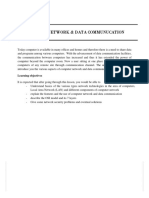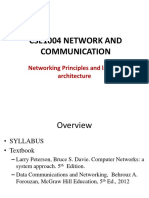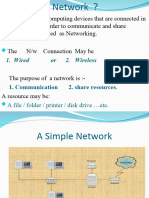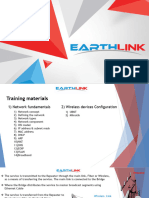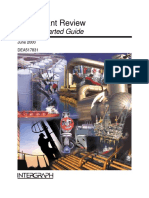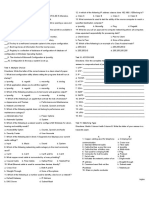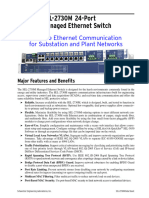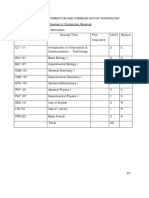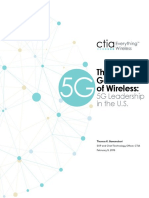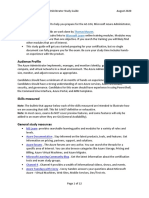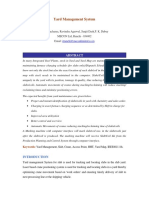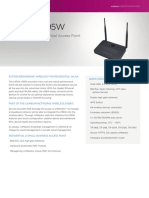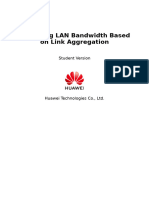Networking Cloud Computing
Uploaded by
dhanaapashanNetworking Cloud Computing
Uploaded by
dhanaapashanCONCEPT OF COMPUTER NETWORK
Q. What is computer network ?
----> A computer Network is a group of two or more
computers interconnected via cable or through
wireless mode ,for the purpose of communication
and sharing the hardware and software resources.
HISTORY OF INTERNET
ADVANTAGES OF NETWORKING
Share Data (Increase Productivity)
Share Hardware Such as a printer,HD,etc.
Share Software (Such as a Office Oracle etc.)
Share License (one issued license on many)
Saving money, space and time.
DRAWBACKS OF COMPUTER
NETWORK
1.High Installation Cost
2.Risk of Hacking
3.Hardware Damages
NETWORK CRITERIA
A network must meet a certain number of criteria
and most important criteria are
1.Performace.
2.Reliability.
3.Security.
1.PERFORMANCE
Performance of a network can be measured in many ways
such as a 1.transits time and response time and
2.second is more throughput and less delay .
RELIABILITY
Network Reliability is measured by frequency of its failure, the time
taken by link to recover from a failure
Diagram
A
Diagram
B
SECURITY
Which policy used to secure network (Example Antivirus,
firewall, Monitoring software
NETWORK TERMINOLOGY
Server :- who gives the service to client
Client :- Who accept the services from server
Node :- Any devices which can communicate each other in a network. OR
anything that is connected to the network.
Segment :-A group of pc
Backbone :-That wire who connect all pcs.
source :- where data is coming from.
Destination :-when data is going to
Packet :-a collection of bits in order assembled for transmission
Topology :- the way that each node is physically connected to the network.
Bit :- Binary digit, either 0 or 1
Bandwidth:- the amount of data which can be sent on a channel. Usually
bits per second-sometimes in bytes per second.
BANDWIDTH
Slide 2: What is a Computer Network?
• A computer network is a group of two or more interconnected
computers that can communicate and share resources like files,
internet access, printers, and applications.
• Networks can be categorized based on:
• Size
• Distance
• Purpose or use case
Slide 3: Classification of Networks
• PAN (Personal Area Network)
• LAN (Local Area Network)
• SOHO (Small Office/Home Office) Network
• CAN (Campus Area Network)
• Enterprise LAN
• MAN (Metropolitan Area Network)
• WAN (Wide Area Network)
Slide 4: PAN – Personal Area Network
• Definition: A network used for data transmission among devices like phones,
laptops, and wearable devices within a very short range (typically within 10
meters).
• Technologies Used: Bluetooth, Infrared, USB, Wi-Fi.
• Examples:
• Connecting a smartphone to wireless headphones
• Smartwatch syncing with a mobile phone
Advantages:
• Convenient
• Low power consumption
Disadvantages:
• Limited range
• Low data transfer speed
Slide 5: LAN – Local Area Network
• Definition: A network that connects computers and devices in a limited area like a home,
office, or school.
• Range: Up to a few kilometers
• Speed: Typically high (100 Mbps to 10 Gbps)
Advantages:
• High data transfer rate
• Easy to set up and manage
• Cost-effective for small areas
Examples:
• School computer lab
• Office network in a single building
Slide 6: SOHO – Small Office/Home Office Network
• Definition: A LAN designed for a small business or home-based work environment.
• Components: Router, modem, desktop/laptop PCs, printer, storage devices
• Range: Covers a small location like an apartment or small office
Benefits:
• Easy to install with minimal IT knowledge
• Affordable hardware and networking equipment
Use Case:
• Freelancers or entrepreneurs working from home
• Small agencies with 3–10 employees
Slide 8: Enterprise LAN
• Definition: A large-scale LAN infrastructure tailored for corporate and enterprise environments.
• Scope: May span across multiple floors or buildings, but within a local region
• Components: Routers, switches, firewalls, servers, enterprise-grade Wi-Fi
Features:
• Highly secure and scalable
• Centralized IT control
• Supports thousands of users
Examples:
• Network infrastructure of a multinational company HQ
• Banking networks in a regional office
Slide 7: CAN – Campus Area Network
• Definition: A network that connects multiple LANs within a campus such as a university,
military base, or large company campus.
• Size: Larger than a LAN but smaller than a MAN
• Purpose: Centralized resource sharing among different departments or buildings
Advantages:
• High-speed connectivity across the campus
• Centralized management and resources
Examples:
• University network connecting different buildings
• Hospital network spanning several wings or buildings
Slide 9: MAN – Metropolitan Area Network
• Definition: A network that spans an entire city or metropolitan area, interconnecting multiple LANs.
• Range: 5 to 50 kilometers
• Usage: Often used by cities, universities, or large organizations for urban connectivity
Advantages:
• High-speed and high-capacity
• Connects geographically separated LANs
Examples:
• City-wide government network
• Large hospital system across a metro region
Slide 10: WAN – Wide Area Network
• Definition: A network that spans large geographical areas such as countries or
continents.
• Internet is the most well-known WAN
• Technologies Used: Fiber optic cables, satellites, MPLS, leased lines
Characteristics:
• Low data transfer speed compared to LAN
• Expensive and complex setup
Examples:
• Corporate network connecting offices in different countries
• Internet
Network Type Full Form Area Covered Range Speed Common Users
PAN Personal Area Network A few meters Up to 10 meters Low to Medium Individuals
LAN Local Area Network A building or room Up to 100 meters High Homes, schools, offices
Small Office/Home Small business/home
SOHO A house or small office ~10–100 meters Medium
Office users
CAN Campus Area Network Multiple buildings Up to 1–5 kilometers High Universities, companies
Enterprise LAN Enterprise Local Area Large buildings Up to several hundred High Large businesses
Network meters
Metropolitan Area
MAN A city 5–50 kilometers Medium Government, ISPs
Network
ISPs, multinational
WAN Wide Area Network Country/continent-wide Over 50 km to global Variable
corporations
TRANSMISSION MODES
Simplex:- Information flows in only one direction, Examples are radio and television
broadcasts. They go from the TV Station to your home television.
HALF-DUPLEX
Information flows in two directions, but only in one direction at a time. For
example, a conversation on walkie talkies is a half-duplex data flow. Each
person takes turns talking.
FULL DUPLEX
Information flows in two Directions of the same time Modems are configured to
flow data in both directions.
Networking
Device
NETWORKING DEVICES
NIC Card:- Network Interface Card
NIC stands for Network Interface Card. Sometimes it is also called by the name
“Network Interface Controller”. It is indeed a circuit board or a card that is installed in
a computer so that it can be connected to a network. Actually the network interface
card provides the computer with a dedicated, full time connection to a network.
HUB:-
Hub is a Centralized device.
More than two Computers we need a device
called hub to interconnect
Always and always Broadcast device.
It is Dummy Device not intelligent.
Pure hardware and physical layer (Layer 1)
device.
-Single collision domain (it means it work on
half duplex) .
NETWORKING DEVICES
Repeater:-
Repeater is a network device which used to regenerate or replicate a signal. It
removes the unwanted noise in an incoming signal. Repeater operates at Layer 1 of
OSI.
Bridge:-
Bridging :- connects two separate networks as if
they were a single network. Example :- hub to
hub connectivity
5. Switch
• Definition: A smarter device that connects devices in a LAN and sends data
only to the intended device.
• Function: Reduces network congestion, increases efficiency.
• Layer: Data Link Layer (Layer 2), sometimes Layer 3 (for Layer 3 switches).
Types of Switches
1.Unmanaged Switch
1. Simple plug-and-play; no configuration required.
2.Managed Switch
1. Provides advanced features like VLANs, traffic control, and remote
management.
3.Layer 2 Switch
2. Operates at the Data Link Layer; uses MAC addresses to forward data.
4.Layer 3 Switch
3. Supports routing functions and works at the Network Layer.
Manageable Vs
unmanageable
8. Ethernet to Ethernet Modem
• Definition: A modem that connects Ethernet devices to the Internet
via a broadband connection.
• Function: Converts digital Ethernet signals to a format usable by ISPs
(and vice versa).
• Use Case: Common in DSL, Cable, or Fiber-optic internet setups.
6. Gateway
• Definition: A network node that connects different networks using
different protocols.
• Function: Translates communication between different systems (e.g.,
LAN to Internet).
• Layer: All layers (mainly Layer 5 to 7).
ROUTER
Router is a device connects two different networks.
Router is an intelligent device which can select the best path on the basis
of routing protocol.
Router is a device which integrates both LAN & WAN.
It works on layer 3 (network layer)
Network Categories
There are two main types of network models:
1.Peer-to-Peer (P2P) Network
2.Client-Server Network
Peer-to-Peer (P2P) Network
Definition:
All computers act as equals, sharing resources directly without a central server.
Features:
• No dedicated server
• Each device is both a client and a server
• Easy and inexpensive to set up
Advantages:
• Low cost
• Easy to install
• Direct resource sharing
Disadvantages:
• Less secure
• Poor scalability
• Difficult to manage large networks
• Example:
File sharing in a small office or home
Client-Server Network
Definition:
A centralized server provides services and manages resources for client devices.
Features:
• Dedicated server(s)
• Centralized control
• Clients request services (files, printing, etc.)
Advantages:
• Better security and control
• High performance and scalability
• Easier maintenance and backups
Disadvantages:
• Higher cost
• Requires administration
• Server failure can disrupt services
• Example:
Banking systems, school networks, websites
Topology
A topology is defined as the arrangement of network Devices. There are
two types topology available first is Physical and another is logical
Physical VS Logical
If in a network topology the computers in the network are connected
with the help of cable or any other physical medium then it is called a
physical topology
When the Devices in the network are logically connected with the help
of wireless device then it is called Logical topology
Advantages of Bus Topology
• It is easy to install
• It has low installation cost
• It is useful in for small networks
Drawbacks of Bus Topology
• It can break down in case there is a fault in the network backbone
• Its efficiency decreases if the number of devices connected to the
backbone
• It is unsuitable for high data traffic
Advantages of Star Topology
• If there is a node failure then, only that particular node if affected. All
other nodes connected to the central node remain unaffected
• Easy to add or Remove Device in network without affecting the entire
network
Drawbacks of Star Topology
• If the central device goes down, the whole system goes down
• It requires more cabling
• Installation cost are high as this layout require more cable
Advantages of Ring topology
• There is no need of server to control the connectivity among the nodes in
the topology.
• It is cheap to install and expand.
• Minimum collision.
Disadvantages of Ring topology :
• In order for all the computer to communicate with each other, all
computer must be turned on.
• Addition and removal of any node during a network is difficult and may
cause issue in network activity.
• Due to the Uni-directional Ring, a data packet (token) must have to pass
through all the nodes.
HYBRID TOPOLOGY
Combination of different topology is called as hybrid topology -- ex bus
topology is connected to ring topology
What is transmission medium
Answer:- in data communication terminology, a
transmission medium is a physical path between
the transmitter and the receiver it means
it is the channel through which data is sent from
one place to another. transmission media is
broadly classified into the following types.
Explanation
• Wired(guided) A. . Wireless(unguided) B.
Two types of transmission medium
•Wired (guided medium)) wireless (unguided medium
1.Coaxial cable 1.radio wave
2.Twisted pair cable(utp or ste) 2.infrared
3.Fibre optic-cable 3.microwave
Wired
Wired medium has a defined physical path for
transmitting signals because it is made up of
physical cables. Therefore, it is known as a
guided medium. The wired medium uses
three types of cable. Data (in the form of
electromagnetic signals) is transmitted using
specially designed network cables; either made
of copper or fiber
Difference bet copper and fibre
• Copper: copper can transmit signals in the form of current
and is vastly used in data transmission. The twisted pair cables
and coaxial cable are mainly made up of copper.
•Fibre: fibre is another means of transmitting data over the
network. Unlike copper cables, fibre optic cable can transmit
the signals in the form of light. The fibre optic transmission is
much faster as compared to copper wires.
Categories of Twisted Pair Cable
• The twisted pair cable can be categorized
into:- Unshielded Twisted Pair (UTP) and
Shielded Twisted Pair (STP)
• UTP Cable STP Cable
Different Categories of Unshielded
Twisted Pair Cable (UTP)
• 1 CAT 1: CAT 1 cable is also called as level 1 cable or category 1
cable. it is a UTP cable mainly used for voice and telephonic
communication. Data Rate Up to 1Mbps.
• 2 CAT 2: cat2 cable is also called as category 2 cable. It is used
for both telephone and data communication and can transmit
data at a rate of up to 4Mbps. It is used in token ring network
• 3 CAT 3: cat 3 cable is also called as category 3 cable or station
wire . it is used for both voice and data communication. Data
rate of up to 10 Mbps. It is used in token ring and 10BASE-
T.
and provides transmission range of 100 meters
• CAT 4 :CAT 4 cable is also called as a category four cable.it is a
twisted pair cable which can be used in a token ring network
and can transfer data at a rate of up to 16 Mbps. and provides
transmission range of 100 meters
• CAT 5 : cat 5 cable is also called as category 5 cables. It supports data
transmission speed up to 100 Mbps. However the transmission range of
cat 5 cable is limited to 100 meter's only.
• CAT 5e : cat 5 e is an enhanced version of CAT 5 cable. It was officially
launched in 2001 by the EIA/TIA. The data transmission sped of cat 5e is
much faster as compared to cat 5 cable. It support data transfer speed up
to 1000 Mbps(1Gbps) and provides transmission range of 100 meters.
• CAT 6 : CAT 6 cable is also called as category 6 and provide data
transmission speed up to 10Gbps. Further , it can also be used with CAT 5
and CAT 5e standard. further ahead, it provides a transmission range of
100 meters however the cost of CAT 6 cables is much higher as
compared to CAT 5 and CAT 5e cables.
• CAT 6a : CAT 6a can transfer data at a rate of 10 Gbps over 100 meter's
of cable.
• CAT 7 : cat 7 cable is also called as category 7
cable.it has four twisted pair cables and can transfer
data at a rate of 10000 Mbps (10Gbps). cat 7 is used
in both Ethernet as well as Gigabit Ethernet.
Data transfer range 100m.
• CAT 8 : is called category 8 cable .data rate
25Gbps/40 Gbps and data transfer range 30m
• Plenum Cable: plenum cable is used for air
conditioning in a building between the
structural ceiling and suspended ceiling. In
plenum cable,
fire-redundant coating is used so that in case of
fire it does not emit toxic gases or smoke.
What is an RJ45 Connector?
•RJ45 is mostly used with
Ethernet cables while RJ11 is
connecting to telephone
units.
Co-axial Cables
• These cables are also copper based cables
used for data transmission. Figure (D) shows a
co-axial cable:
The most commonly used coaxial
cables are:
• RG 6 : it is a type of coaxial cable which has an impedance of
75 ohms and is commonly used in applications requiring high
frequency and bandwidth. Thus, it is used in the internet,
cable TV, satellite DSS applications, etc.
• RG 59 : RG 59 is a special type of coaxial cable which is used
for low-power video and RF signals. It also has an impedance
of 75 ohms. However, it is much thinner and less shielded as
compared to RG 6.further. it is suitable for applications which
require low lower frequency or bandwidth . Thus, it is
commonly used in cctv installation,baseband applications
etc.
Fibre-Optic Cables
• Fibre-optic cables carry light waves in
comparison to copper cables that carry
electronic waves for data data transmission.
Fibre-optic cables have a high bandwidth
capacity and high speed.
these cables work on the phenomenon of total
internal reflection and consists of three parts
namely . Core, cladding and coating as shown in
Figure (E):
Type of fibre-optic cable
• Single-mode fibre optic cables: in a single-mode fibre
optic cable only one mode of light can propagate. The diametral code of
single-mode fibre optic cable is small and thus it allows only one mode of light.
Single mode of fibre optic cable is used for transmitting data over a long distanse.
They generally have a higher bandwidth and are ideal for remote office and college
campus.
• Multi-mode Fibre Optic Cables: in multi mode fibre optic
cable multiple mode of light can propagate. The diametral code of
multi-mode fibre optic cable is large and can allow multiple mode of light.
Multi-mode fibre optic cable is used for transmitting data over a shorter
distance. It is ideal for audio/video application in a LAN
• Plastic Optical Fibre (POF): plastic optical fibre is the fibre
optic cable made of polymers.it can transmit the light through the core of
fibre. In this type of fibre optic cable high refractive difference is
maintained between the core and cladding.
Wireless Medium (unguided)
• Wireless medium is a unguided and uses an
antenna for data transmission. It uses radio
waves, micro-waves and infrared waves to
transmit data.
Uses of wave
• Radio wave:- such examples Radio, Television,
• Infrared Wave :- TV Remote, toys like remote control car.
• Micro wave:-microwave are most commonly used in satellite
communications, radar signals, nevigational applications,
medical treatment.
History
•Ethernet is a Most Common Lan Protocol. The precursor to
Ethernet was invented by xerox in 1983. xerox teamed up
with intel and digital equipment corporation (DEC) to
develop DIX Ethernet, which eventually became
ethernet .These companies handed over the responsibility of
developing Ethernet standards to IEEE in the early 1980s
•IEEE formed two committees to work on Ethernet - IEEE
802.2 committee and IEEE 802.3 committee
•The IEEE 802.2ncommittee deals with the upper layer of data
link layer ,also known as logical link control (LLC) Layer. IEEE
802.3 committee deals with the physical layer standards and
subpart of the data link standards.
Ethernet Deployment Standards
10Base5 :- This standard is also known as a thick Ethernet
This standard uses bus topology and cable is very thick and very tough to bend
The transceiver is connected externally to the cable
The transceiver is used for transmitting, receiving and detecting collisions.
10Base2
This standard is also known as thin Ethernet.
This cable is much thinner and flexible than the 10Base5 standard
Use in bus topology
10Base-T
This standard also known as twisted pair ethernet.
This uses star topology
It use a RJ-45 connector.
100BaseTX (IEEE 802.3u)
This standard uses a category 5,6 or 7 UTP two-pair cable.
Addressing
IP Address Mac Address
IPV4 & IPV6
Physical or MAC (Media Access Control)
Address
• MAC Addresses are 6 bytes (or 48 bits long), providing 281,474,976,710,656
addresses in theory. In order to make these addresses easier for humans to
remember, these addresses are usually written as six two-digit hexadecimal
numbers, such as 01:23:45:67:89:AB .
Internet Protocol
• IP stands for Internet Protocol
version v4 stands for Version Four (IPv4), is the
most widely used system for identifying devices on
a network. It uses a set of four numbers, separated
by periods (like 192.168.0.1), to give each device a
unique address. This address helps data find its
way from one device to another over the internet.
• IPv4 was the primary version brought into action
for production within the ARPANET in 1983. IP
version four addresses are 32-bit integers which
will be expressed in decimal notation. Example-
192.0.2.126 could be an IPv4 address.
What is ip address?
• Ip address stands for “internet protocol” an ip
address is a unique number provides to each
an every device.
IPv4
• Length 32 bits
• Octet 4
• 0 to 255 (Possible value in any octet)
• 112.211.110.0 (Example of IPv4 address)
Difference
Class of IPV4
What is APIPA?
• APIPA stands for automatic private internet
protocol addressing. It's a feature in some
operating systems, like Windows, that
automatically assigns IP addresses to devices
on a network when no dynamic host
configuration protocol (DHCP) server is
available. Range is 169.254.0.0
Loopback
• The loopback address commonly known as “localhost” is
an internal address that directs network traffic
bacLoopback refers to a communication
method where the sender and receiver are
the same device, allowing it to send data to
itself. This concept is commonly used in
networking and software development for
testing and troubleshooting purposes' to the
same device. Ex
• IPv4 range 127.0.0.0/8
• IPv6 Range ::1
Reserved ip address
• D Multicast (This address is used by device
for send message example :- printer, router)
• E Research and Development
What is Subnet Mask ?
• Network ID + Host ID = IP Address
CIDR
Classless Inter-Domain Routing (CIDR) use to
identify how many bits are reserved for network
Find out The Network Id of this IP Address ?
• Network id + host id = ip address
• 10.1.1.100 (10.0.0.0)
• 130.19.1.20 (130.0.0.0)
• 192.168.1.10 (192.168.1.0)
Convert Decimal to Binary
192.168.10.200 Convert Into Binary
submetting
• 1-5 10
• 192.168.1.0 (convert to bineary)
• Step1-192.168.1.00000000(convert host party into
bineary)
• Step2-2n-2>=15
• N=32-2=30
• N=5
• Step5-192.168.1.00000000
• 192.168.1.11000000
• 192.168.1.244(value)
• 255.255.255.0(defult submet mask)
• 255.255.255.224(new submet mask)
• Step4-192.168.1.0\27
• 192.168.1.32/27
• 192.168.64/27
• 192.168.1.96/27
• 192.168.1.128/27
• 192.168.1.160/27
• 192.168.1.192./27
• 192.168.1.224/27
• 192.168.1.0/28 submeet mask
• 172.16.0.0/10 submet
IPV4 and IPV6 Header
IPv6 Types
The OSI Model
• The Open System Interconnection (OSI) Reference Model Describes How a
Software application On Another Computer .This Model Was Developed in
The Year 1984 by the International Organization for Standardization (ISO),
a multinational Organization responsible for the world wide agreement on
international standards.
Image of OSI Model
1.Physical Layer
The Physical Layer Deals With The:-
• Transmission Medium:-It Defines The Type of Transmission Medium it Means Which
Transmission Medium is Used For Sending Data (Guided Or Unguided)
• Representation of Bits:- the Data in the physical Layer Consists of a stream of bits i.e.
the sequence of 0 and 1. The Physical Layer Defines How These bits are converted
into signals.
• Transmission Rate :- The Transmission Rate is The number of Bits Sent per second.
The physical layer defines the rate as it depends on the type of transmission medium
is used.
• Synchronization of bits:- for the data to be consistent, the sender and the receiver
should use the same bit rate and their clocks should be synchronized.
• Line Configuration:- Physical Topology is the way devices are connected in a
network. There are a different types of topologies: star, mesh, bus, hybrid and ring.
• Transmission Mode:- Physical Layer Also Deals with the type of Transmission Modes.
There are three types of transmission Modes simplex, Half-Duplex, Full Duplex.
2.The Data Link Layer
• The Data link layer Makes the Transmissions of data error-free. It handles
error control and flow control of the data ensures that the delivered
messages are error free. Further, it converts the physical layer into a
reliable link.
Responsibility of Data link layer
• Framing:- The Data link layer Formats The Stream of bits received from the Physical
Layer Into Frames.
• Physical Addressing :- The Data link Layer Adds a Header Containing The MAC
Address of Source and Destination.
• Flow Control:- If The Rate of Data received by the receiver is less than the rate of
data sent by the sender, then the data link layer applies a flow mechanism to control
the flow of data at the receiver’s end.
• Error Control:- The Data Link Layer Detects and re-transmit lost or damaged
frames and provides reliability to the physical layer. Further it also has a mechanism to
check duplicate frames to avoid errors by adding a trailer at the end of each frame.
• Access Control:- When Two or More Devices are Connected to a link at a time,
then the data link layer resolve the conflict of control over the link by hop-to-hop
delivery.
• Hop to hop Delivery Of packets
Explain Access Control
3.The Network Layer
• The Network Layer, also known As a layer 3, is
responsible for the source to destination
delivery of packets.
The Responsibility Network Layer
• Logical Addressing:- The Data link Layer Adds a
Header Containing in this Header ip Address of
Source and Destination.
• Routing:- The delivery of Packets by Routers is Done
by a mechanism called Routing.
5.The Transport Layer
• The Transport layer is responsible for the
process-to-process delivery of the packet. A
Process is an a application running on the
host.
Responsibility of Transport Layer
• Service-Point-Addressing:- The Transport Layer Header includes a
new type of address known as a service point address, or
port address.
• Segmentation and assembly: Packets in the transport layer are divided
into segments, Each segments Contains a sequence number. This helps in
sequential delivery of messages and replace the lost packets.
• Connection Control:- communication provided at the transport layer
can either be connectionless or connection oriented. In a
connectionless Communication, the transport layer sends each
segment independently to the destination. In a connection-
Oriented communication, the transport layer first establish the
connection and then delivers the packets.
• Transport Layer Also Provides Process to process Flow control and error
control
Flow Control
• Flow Control can be Achieve by using Buffer
Control
Connection less Vs. Connection Oriented
6.The Session Layer
• The Session Layer is Responsible for the establishment, maintenance and
synchronization of the interaction between communicating system.
The Responsibility of session Layer is
1.authentication:-
2.synchronization:-The session Layer Achieve Synchronization By adding check
points or synchronization points while transferring the data. For example , if a node is
transmitting data of size 10 GB, Then The Session Layer Will Insert Check Points, If the
Data is lost at some point , then it can be recovered and Re-sent after the latest Latest
Checkpoint. there Will Be No Need of Re-sending The Entire Data
3.it allows the two process to enter a dialog. It allows them to communicate either
in half-duplex or full duplex mode
The Presentation Layer
• The Presentation layer deals with the syntax
and the semantics of the information
exchanged between two systems.
• The Presentation Layer Deals with the:-
Translation, Encryption, Compression.
• Translation: Different Computer Use Different Kinds of encoding
Systems. The Presentation Layer is responsible For the Translation of Data, so that
the two application two different encoding system can read the data sent by each
other. It translate data according to the encoding system used by the receiving
system.
• Encryption:- The Presentation Layer is also responsible for encryption to
ensure privacy. A system can carry sensitive information after applying encryption.
Conversion of original data into an a unreadable format is known as a encryption.
And conversion of unreadable data into the original format is known as a
decryption.
• Compression: While Transmitting a Large Amount of data , data
compression is applied to send the data efficiently. It reduce the number of bits
contained in the information
The Application Layer
• The application layer is responsible for providing services to
the user. It provides user interface and services to the user.
TCP/IP
• TCP/IP is a data link protocol used on the internet
to let computers and other devices send and
receive data. TCP/IP stands for Transmission
Control Protocol/Internet Protocol and makes it
possible for devices connected to the internet to
communicate with one another across networks.
• Originally developed in the 1970s by DARPA (the
Defense Advanced Research Projects Agency in
the US), TCP/IP started out as just one of many
internet protocols. The TCP/IP model later
became the standard protocol for ARPAnet, the
modern internet’s predecessor. Today, TCP/IP is
the global standard for internet
WHAT is TCP/IP
• TCP/IP is a set of protocols developed to all allow
cooperating computers to share resources across a
network
• TCP stand for- transmission control protocol
• There are transport layer and network layer protocols
respectively of the protocol suit
• The most well known network that adopted
• TCP/IP is internet –the biggest WAN in the world
protocol
protocol is a set of rules helps to send data
and verity of protocol are available and all
protocols performances difference
responsibility
Application layer protocols
The Application Layer is the top most layer
in the Open System Interconnection (OSI)
model. This layer provides several ways for
manipulating the data which enables any
type of user to access the network with
ease.
telnet
• telnet stand for Teletype Network
• Use for gain remote access of devices
• Work on port number 23
• But telnet is not secure because it is not
provide encryption so that hacker can view
data
Ssh
• Ssh stand for secure shall
• Use to gain remote access of devices
• Work on port number 22
• It is secure because it provide encryption
ftp
• Stand for File Transfer Protocol
• By using ftp protocol we can upload download
delete data from one host from one host to
another host
• Work on port number 20 , 21
• Deta send 20
• Connection 21
TFTP
• TFTP stands for Trivial File Transfer Protocol
• It is a simple way to transfer files between
servers and computers. TFTP is faster than
some other protocols, but also less secure. It's
generally used for transferring small files.
• Fast as compare to ftp
• Port number 69
SNMP
• SNMP stand for Simple Network Management
Protocol
• Use to monitor network
• Port number 444
SMB
• SMB stand for Server Message Block
• (SMB) protocol is network communication
protocol for providing shared access to files,
printers, and serial ports between nodes on a
network.
• Port number 445
NTP
• NTP stand for Network Time Protocol
• (NTP) is a protocol designed to time-
synchronize a network of machines.
• use set computer time
• Port number 123
NFS
NFS STAND FOR Network File System
(NFS) is a distributed file system protocol
originally developed by Sun Microsystems
(Sun) in 1984, allowing a user on a client computer
to access files over a computer network much like
local storage is accessed.
port number 2049
DNS
• DNS stand for Domain Name System
• (DNS) turns domain names into IP addresses,
which browsers use to load internet pages.
• port number 53 tcp and udp
TCP
• TCP stand for Transmission Control
Protocol
• is a communications standard for
delivering data and messages
through network
•
UDP
• UDP stand for User Datagram Protocol
• (UDP) refers to a protocol used for communication throughout the
internet. It is specifically chosen for time-sensitive applications like
gaming, playing videos, or Domain Name System (DNS) lookups.
• Work on port number 53
dhcp
• Dhcp stand for Dynamic Host Configuration
Protocol
• (DHCP) Meaning. What is DHCP? Dynamic Host
Configuration Protocol (DHCP) is used to
dynamically assign Internet Protocol (IP) addresses
to each host on your organization's network.
• work on port number 67 , 68
• Client port number 68
• Server port number 67
• Dynamic Host Configuration Protocol(DHCP) uses the DORA process for assign ip address
• ++++++++++++++
• 1-Discover (Client) , Port number 68
• ++++++++++++++
• DHCP client will find the server by sending DHCP discover message
• ___________________________________
• +++++++++++++++++
• 2-Offer (server) , Port number 67
• +++++++++++++++++
• The server sends a DHCP offer message with filled information. like ip address,lease
duration,subnetmask.
• ++++++++++++++++++
• 3-Request (client) , port number 68
• ++++++++++++++++++
• The device sends a request Message (requesting the offered ip address by server)
• +++++++++++++++
• 4 - Acknowledgment (server), port number 67
• This is the last step or message in the DORA process. The DHCP server sends Acknowledge
Message to the client when it receives the request message from the DHCP client.
HTTP
• HTTP stand for Hyper Text Transfer Protocol
• the computer communication protocol used for
most communication on the world wide web. The
protocol is the set of rules that actually conducts
the client/server interaction between your web
browser and the destination web page.
• It is not secure because it not provide encryption
• Port number 80
HTTPS
• HTTPS stand for Hypertext Transfer Protocol
Secure
• (HTTPS) is an extension of the Hypertext
Transfer Protocol (HTTP). It uses encryption
for secure communication over a computer
network, and is widely used on the Internet.
• Port number 443
SMTP
• SMTP stand for -Simple Mail Transfer Protocol
• Use to send email
• Work on port number 25
pop
• Pop stand for - Post Office Protoco
• use for recovery
• Work on port number 110
• popV3 stand for -Post Office Protocol version 3
• which provides access to an inbox stored in an
email server. It executes the download and
deletes operations for messages.
• Work on port number Port 110
ARP (Address Resolution Protocol)
• ARP stands for Address Resolution Protocol.
ARP is used to convert the logical address ie.
IP address into physical address ie. MAC
address. While communicating with other
nodes, it is necessary to know the MAC
address or physical address of the destination
node.
RARP
• RARP stands for Reverse Address Resolution
Protocol. RARP works opposite of ARP. Reverse
Address Resolution Protocol is used to convert
MAC address ie. physical address into IP
address ie. logical address.
ICMP
• ICMP stands for Internet Control Message
Protocol. ICMP is a part of IP protocol suite.
ICMP is an error reporting and network
diagnostic protocol.
IMAP
• The Internet Message Access Protocol is an
application layer Internet protocol that allows
an e-mail client to access email on a remote
mail server.
You might also like
- 4.2 Computer Network & Data CommunicationNo ratings yet4.2 Computer Network & Data Communication26 pages
- Computer Network & Data Communication f3No ratings yetComputer Network & Data Communication f316 pages
- Computer Networks and Data CommunicationNo ratings yetComputer Networks and Data Communication15 pages
- Basic Networking: Introduction To Computing Unit 5No ratings yetBasic Networking: Introduction To Computing Unit 525 pages
- Networking Fundamentals: by Praphul KolteNo ratings yetNetworking Fundamentals: by Praphul Kolte31 pages
- Module 1 - Networking Principles and Layered ArchitectureNo ratings yetModule 1 - Networking Principles and Layered Architecture121 pages
- Introduction To Computer Networks Session 1No ratings yetIntroduction To Computer Networks Session 150 pages
- Software Defined Networks: Instructor: Dr. Neha AgrawalNo ratings yetSoftware Defined Networks: Instructor: Dr. Neha Agrawal30 pages
- 12-Informatics Practices - Unit 3-Computer Networking-Notes and Video Link100% (2)12-Informatics Practices - Unit 3-Computer Networking-Notes and Video Link19 pages
- Introduction To Computer Networks: V Sahana Xii A 12108No ratings yetIntroduction To Computer Networks: V Sahana Xii A 1210843 pages
- Smartplant Review: Getting Started GuideNo ratings yetSmartplant Review: Getting Started Guide33 pages
- SEL-2730M 24-Port Managed Ethernet Switch: Reliable Ethernet Communication For Substation and Plant NetworksNo ratings yetSEL-2730M 24-Port Managed Ethernet Switch: Reliable Ethernet Communication For Substation and Plant Networks8 pages
- Curriculum For B.Sc. Degree in Computer Science 100 Level Harmattan Semester Course Code Course Title Pre-Requisite Units StatusNo ratings yetCurriculum For B.Sc. Degree in Computer Science 100 Level Harmattan Semester Course Code Course Title Pre-Requisite Units Status18 pages
- Business IP Range Administration and Provisioning ManualNo ratings yetBusiness IP Range Administration and Provisioning Manual175 pages
- SIPROTEC 4 7SD61 Differential Protection Relay For Two Line EndsNo ratings yetSIPROTEC 4 7SD61 Differential Protection Relay For Two Line Ends26 pages
- The Next Generation of Wireless:: 5G Leadership in The U.SNo ratings yetThe Next Generation of Wireless:: 5G Leadership in The U.S16 pages
- BCA 101: Computer Fundamental & Programming: Department of Computer Science & Applications 1No ratings yetBCA 101: Computer Fundamental & Programming: Department of Computer Science & Applications 119 pages
- High Performance Big Data Analytics Computing Systems and Approaches Compress100% (1)High Performance Big Data Analytics Computing Systems and Approaches Compress443 pages
- ARTICLE 29 DATA PROTECTION WORKING PARTY - Opinion 5/2009 On Online Social Networking100% (1)ARTICLE 29 DATA PROTECTION WORKING PARTY - Opinion 5/2009 On Online Social Networking13 pages
- T-7700 Series IP Network Audio A Cquisition Terminal T-7770No ratings yetT-7700 Series IP Network Audio A Cquisition Terminal T-77701 page
- Pilot r195W: Cloud Managed Residential Access PointNo ratings yetPilot r195W: Cloud Managed Residential Access Point2 pages
- 02 (Optional) Improving LAN Bandwidth Based On Link AggregationNo ratings yet02 (Optional) Improving LAN Bandwidth Based On Link Aggregation10 pages
- Huawei FusionServer IBMC Software White PaperNo ratings yetHuawei FusionServer IBMC Software White Paper57 pages















